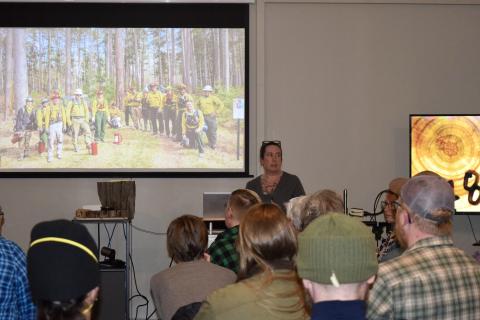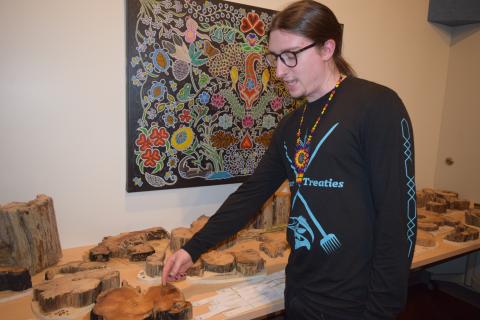
Partnerships ignite new conversations about ishkode management By Jenny Van Sickle, GLIFWC Outreach Specialist Over a decade of collaboration among researchers, tribal communities, state, and federal land managers put Nimaawanji’idimin giiwitaashkodeng: “We are all gathering around the fire” into motion. Damon Panek, Fond du Lac Band wildland fire operations specialist, and Evan Larson, professor at UW-Platteville, welcomed a crowd (in person and virtual) of nearly 200 people to January’s River Talk at the Lake Superior Estuarium to provide the public with an update on their work to return fire (ishkode) management to regional landscapes. “This project is focused on understanding local history, people, fire, and how they interacted on Wisconsin and Minnesota Points,” said Larson.
GLIFWC Traditional Ecological Knowledge Outreach Specialist Melonee Montano, a Red Cliff tribal member and University of Minnesota graduate student is co-leading the fire initiative. Montano recalled fond memories of hearing fire stories from family members and elders. She stressed the importance of telling an accurate history of Indigenous experiences and the consequences of native people being “forcibly separated from fire” is just one of the many stories that need to be told. More broadly, the greater scientific community argued that historic wildland fires were caused by lightning strikes. But, according to dendrochronology studies, fire prevalence dropped to almost nothing after the treaty era. Montano joked that “lightning didn’t stop striking as soon as the treaties were signed.”

Federal laws like the Nelson Act of 1889 heavily criminalized any use of fire. Tree samples show evidence of fire every 4-6 years further demonstrating that the pre-treaty era wildland fires were human caused and intentional. The presentation also highlighted the work of four Fond du Lac Tribal Community College (FDLTCC) student interns who took turns presenting to the crowd before they were joined by a group of gidakiimanaaniwigamig science camp elementary students who also took part in the tree ring data study. FDLTCC students Ashla Ojibway, Mocha Reynolds, and Valerie Zhaawendaagozikwe, were joined on the project by Emily Lockling, who is studying at the University of Minnesota Duluth. Ashla Ojibway, an Environmental Science Major, said, “to be a part of this project was a dream. As soon as I got the ok I was in, I called my dad, I cried.” Vern Northrup, a Fond du Lac tribal member and retired BIA Wildland Fire Operations Specialist is excited about the momentum this work is gaining. “For over 100 years, the loudest message about fire is that it’s one dimensional and primarily dangerous,” said Northrup. He explained that species like red pine are fire dependent and returning fire to the landscape is vital to restoring strong pine stands and blueberry harvests. Northrup also points out that we know bald eagles prefer to nest in red pines and reintroducing fire can protect that resource as well as reduce the threat of unchecked forest fuels and wildfire. “Applying fire to a landscape can be done skillfully, safely, and effectively. We know how to do this,” said Northup.
Larson acknowledged that disciplines like geology and archaeology are finally catching up to Indigenous teachings. He reminded the audience that the forest across this region is intentional and is the result of people and their management. Panek agreed and added, “The developing forest of today is more homogenous and changing species and that is a serious concern particularly when considering reserved treaty resources and rights.” One example is that traditional canoe building depends on the pitch, or waterproof resin, that pine trees produce following a fire. Chief Osaugie, a renowned canoe builder, lived on Wisconsin Point. Melonee Montano, GLIFWC’s Traditional Ecological Knowledge outreach specialist and Red Cliff member explains the historic relationship of ishkode (fire) within Native families. Montano also stressed the importance of Indigenous knowledge in fire restoration initiatives to encourage diverse and healthy ecosystems.
For more information on the remaining Sea Grant Speaker Series, visit tinyurl.com/bp9nb44k Panek encourages everyone to remember that fire has 100’s of uses and benefits, especially during discussions about invasive species, vegetation management, or forestry policies. Nimaawanji’idimin giiwitaashkodeng: “We are all gathering around the fire” is possible thanks to support from Wisconsin Sea Grant. This River Talk can be viewed youtube.com/watch?v=7JX2CrlfuTc. Bazile Panek, GLIFWC’s Tribal Climate Adaptation Menu coordinator motions to tree samples on display at the Lake Superior Estuarium on Barker’s Island in Superior, Wisconsin.
Panek encourages everyone to remember that fire has 100’s of uses and benefits, especially during discussions about invasive species, vegetation management, or forestry policies. Nimaawanji’idimin giiwitaashkodeng: “We are all gathering around the fire” is possible thanks to support from Wisconsin Sea Grant.
Photo:
Melonee Montano, GLIFWC’s Traditional Ecological Knowledge outreach specialist and Red Cliff member explains the historic relationship of ishkode (fire) within Native families. Montano also stressed the importance of Indigenous knowledge in fire restoration initiatives to encourage diverse and healthy ecosystems. (JVS photo).